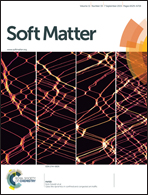Adsorption of rationally designed “surf-tides” to a liquid-crystal interface
Abstract
The interfacial adsorption of proteins in surfactant laden systems occurs both in nature and industrial processing, yet much of the fundamental behavior behind these systems is still not well understood. We report the development of a system that monitors optical transitions of a liquid-crystalline/aqueous interface to examine the dynamics of adsorption of two rationally designed model peptide molecules. The two molecules synthesized in this study were both designed to become surface-active upon folding and contain the same net charge of +3, but one of the peptides, K-2.5, has its three charges separated by 2.5 amino acids as compared to K-6.0, which has its three charges separated by 6 amino acids. Our study examines the roles that surfactant adsorption, peptide charge distribution and secondary structure have on the relative adsorption dynamics of these two models peptides onto a fluid/fluid interface. Using the optical detection of molecular adsorption and image analysis of these events, we obtain quantitative information about the dynamics as a function of the charge spacing and initial peptide concentration. We show that both peptides initially follow a diffusion-limited adsorption model onto the interface. Additionally, our results suggest that the K-6.0 peptides demonstrate enhanced adsorption kinetics, where the enhanced rates are a consequence of the well-folded adsorbed state and spatial distribution on the surface. These findings provide further insights into the role that charge spacing has on secondary structure and subsequently the dynamics of adsorption, while developing a versatile system capable of extracting quantitative information from a simple inexpensive optical system.


 Please wait while we load your content...
Please wait while we load your content...